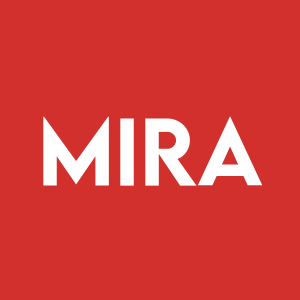MIRA Pharmaceuticals Reports No Brain Toxicity in FDA-Required Study of Ketamir-2, Confirming Absence of Ketamine-Linked Neurotoxicity
Rhea-AI Summary
Positive
- No brain toxicity or Olney lesions detected in FDA-required study, confirming safety profile
- Drug demonstrated superior performance vs FDA-approved treatments in preclinical studies
- Strong oral bioavailability and not classified as controlled substance, potentially streamlining development
- Successfully progressing with Phase I trial enrollment
Negative
- None.
News Market Reaction 1 Alert
On the day this news was published, MIRA gained 2.56%, reflecting a moderate positive market reaction.
Data tracked by StockTitan Argus on the day of publication.
Preclinical data supports the advancement of oral Ketamir-2 as a safe, next-generation alternative to ketamine, with ongoing momentum in Phase I clinical trial enrollment
MIAMI, FL / ACCESS Newswire / May 6, 2025 / MIRA Pharmaceuticals, Inc. (NASDAQ:MIRA) ("MIRA" or the "Company"), a clinical-stage pharmaceutical company focused on developing breakthrough treatments for neurological and neuropsychiatric conditions, today announced positive results from a neurotoxicity study of Ketamir-2, its novel oral NMDA receptor antagonist. The study was required by the U.S. Food and Drug Administration (FDA) prior to initiating human dosing in the United States.
The preclinical study showed no evidence of brain toxicity, including the absence of Olney lesions-vacuolar brain changes historically associated with older NMDA-targeting drugs such as ketamine and MK-801. These results further confirm the favorable safety profile of Ketamir-2 and support its safe continued clinical development.
"These results represent a key milestone in the development of Ketamir-2," said Erez Aminov, Chairman and CEO of MIRA. "The absence of NMDA-linked neurotoxicity, along with continued clinical progress, reinforces our confidence in Ketamir-2's potential as a safe next-generation, oral candidate for CNS disorders."
Study Overview and Key Findings
The neurotoxicity study was conducted in sexually mature Sprague-Dawley rats. High oral doses of Ketamir-2 were administered, while a positive control group received MK-801, a known neurotoxic NMDA receptor antagonist. Brain tissues were examined through detailed histopathological analysis at two time points.
Key outcomes:
No adverse clinical signs or mortality in any Ketamir-2-treated animals.
No microscopic or macroscopic brain lesions detected at any dose.
MK-801-treated animals showed clear evidence of brain toxicity, including vacuolation and neuronal necrosis.
"These findings eliminate one of the main safety concerns that has historically limited NMDA-targeting therapies," said Dr. Itzchak Angel, Chief Scientific Advisor at MIRA. "Ketamir-2's clean neurotoxicity profile strengthens its position as a differentiated and promising therapeutic candidate."
Why Ketamir-2 Stands Apart
Ketamir-2 is a New Molecular Entity (NME) designed to modulate the NMDA receptor with a reduced affinity for the PCP binding site, which is strongly associated with neurotoxicity and psychotropic effects in legacy compounds like ketamine.
In prior preclinical studies, Ketamir-2 has:
Demonstrated full reversal of pain thresholds in validated neuropathic pain models.
Outperformed FDA-approved treatments such as gabapentin and pregabalin.
Shown no sedation or hyperactivity.
Demonstrated strong oral bioavailability and brain penetration, as it is not a substrate for P-glycoprotein (P-gp).
Ketamir-2 was designed for oral administration, offering a non-invasive alternative to intravenous therapies. In addition, the U.S. Drug Enforcement Administration (DEA) has determined that Ketamir-2 is not classified as a controlled substance, which may streamline development, reduce regulatory burdens, and improve future access if approved.
Clinical Progress and What's Next
MIRA has already initiated its Phase I clinical trial, with subject recruitment actively underway and progressing smoothly. The Company is preparing to launch a Phase IIa proof-of-concept trial in diabetic patients with neuropathic pain, with the goal of validating clinical efficacy and supporting future regulatory milestones.
The newly completed neurotoxicity study results will be submitted to the FDA as part of MIRA's ongoing regulatory and clinical development strategy.
Additional information about MIRA Pharmaceuticals is available at www.mirapharmaceuticals.com.
Cautionary Note Regarding Forward-Looking Statements
This press release and the statements of MIRA's management related thereto contain "forward-looking statements," which are statements other than historical facts made pursuant to the safe harbor provisions of Section 27A of the Securities Act of 1933, as amended, and Section 21E of the Securities Exchange Act of 1934, as amended. These statements may be identified by words such as "aims," "anticipates," "believes," "could," "estimates," "expects," "forecasts," "goal," "intends," "may," "plans," "possible," "potential," "seeks," "will," and variations of these words or similar expressions that are intended to identify forward-looking statements. Any statements in this press release that are not historical facts may be deemed forward-looking. Any forward-looking statements in this press release are based on MIRA's current expectations, estimates, and projections only as of the date of this release and are subject to a number of risks and uncertainties (many of which are beyond MIRA's control) that could cause actual results to differ materially and adversely from those set forth in or implied by such forward-looking statements, including related to MIRA's potential merger with SKNY Pharmaceuticals, Inc. These and other risks concerning MIRA's programs and operations are described in additional detail in the Annual Report on Form 10-K for the year ended December 31, 2024, and other SEC filings, which are on file with the SEC at www.sec.gov and MIRA's website at https://www.mirapharmaceuticals.com/investors/sec-filings. MIRA explicitly disclaims any obligation to update any forward-looking statements except to the extent required by law.
Contact Information
Helga Moya
info@mirapharma.com
(786) 432-9792
SOURCE: MIRA Pharmaceuticals
View the original press release on ACCESS Newswire







